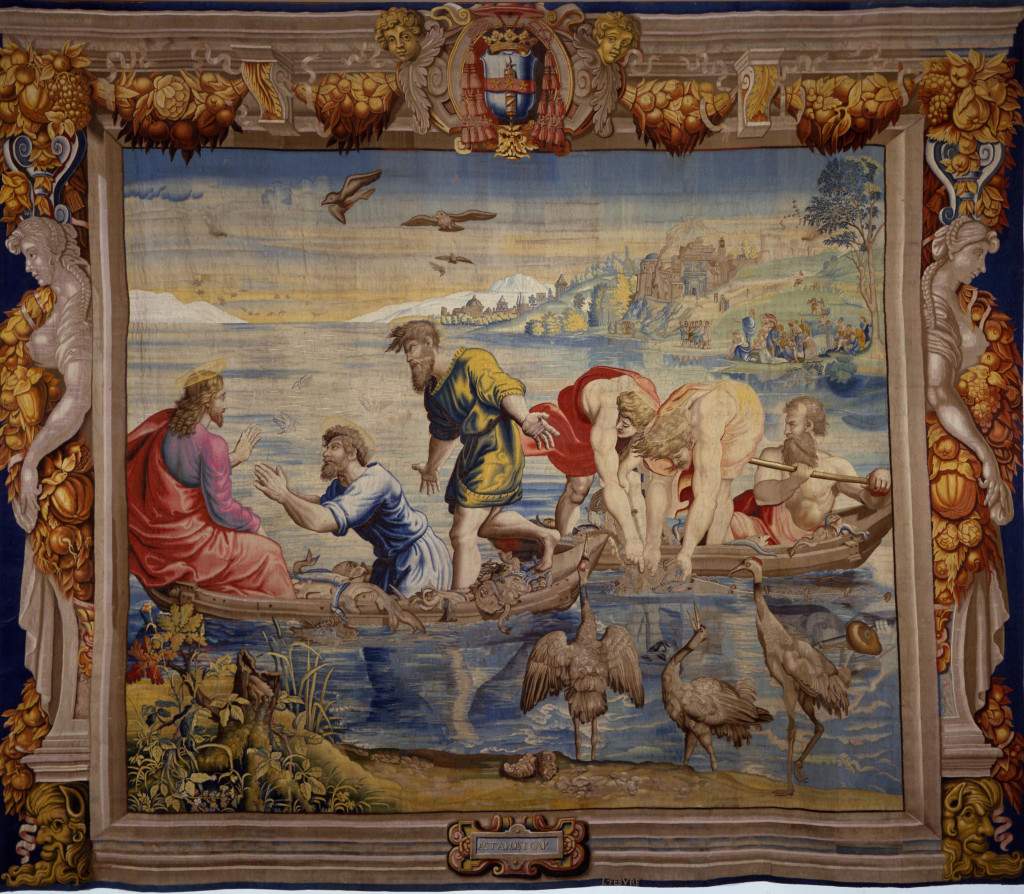The city of Bolzano also joins the celebrations for the 500th anniversary of the death of Raphael Sanzio (Urbino, 1483 - Rome, 1520), and it does so with an exhibition promoted by the Italian Department of Culture to offer a glimpse of the “divin painter”: an exhibition event entitled Raphael. Woven Masterpieces. Fortune and Myth of a Great Italian Genius, scheduled at the Centro Trevi (Trevilab) in Bolzano from October 10 to December 15, 2020. The initiative is part of a journey by which the Culture Office celebrates three figures emblematic for the history of Italian and international culture: last year Leonardo da Vinci, now Raphael Sanzio, and in 2021 it will be the turn of Dante Alighieri.
The exhibition, curated by Anna Cerboni Baiardi (associate professor of Museology and Art Criticism and Restoration at the University degli Studi di Urbino Carlo Bo) brings to Alto Adige the Tapestry of the Miraculous Peach, a large-scale masterpiece made in silk thread between 1653 and 1661, and executed from cartoons drawn by Raphael between 1515 and 1516 for Pope Leo X to complete the Sistine Chapel and now preserved at the Albert and Victoria Museum in London. Loaned by the Galleria Nazionale delle Marche in Urbino, the tapestry is part of one of the valuable series made later on the wave of the extraordinary success of Raphael’s tapestry cycle, which was able to renew this area as well. The work will dialogue with the coeval tapestry of Esther before Ahasuerus, made in 1514 in Basel and owned by the Benedictine convent of Muri-Gries in Bolzano, also displayedit in the exhibition, and with the photographic reproduction of the tapestry of the Washing of the Feet, which came out of the same workshop of Pieter van Aelst (who made the tapestries commissioned by Pope Leo X) and is now preserved in the Tridentine Diocesan Museum in Trent. Also part of the exhibition proposal are videos that provide insight into both the original Vatican series and the other tapestries in the Urbino series.
And again, testifying to the extent to which Raphael’s language had found diffusion, are the prints on display in the exhibition, from the Raphael Academy in Urbino, which reproduce some of his best-known and best-loved works, such as the Sistine Madonna. The Academy has also lent a book collecting engravings of Raphael’s cartoons for the Acts of the Apostles. But that’s not all: in fact, the exhibition wanted to devote special attention to the theme of “accessibility” and was designed to allow enjoyment by all audiences. Within the exhibition, therefore, a tactile section for the blind and visually impaired was planned, as well as dedicated guided tours in collaboration with the Omero State Tactile Museum of Ancona, the Italian Union of the Blind and Visually Impaired of Bolzano and the St. Raphael Blind Center of Bolzano.
With this in mind, a small-scale tactile version (relief print) of the Miraculous Peach tapestry was then created. In the dedicated section, in addition to the reproduction of the bust of the Lady of Urbino from the Museo Omero, two reproductions in the form of tactile bas-reliefs of Raphael’s Muta, specially made for Raphael, will also be on view. Woven masterpieces. The first, in resin, was prepared by the Peppennadia workshop in Pesaro. The second is an experimental research project that originated in Bolzano by Glass Art Design Vetroricerca, whose founders and managers are Alessandro Cuccato and Alessandra Piazza, a workshop specializing in the artistic working of glass, in which artists, designers, architects and researchers from Italy and abroad have transited over the past two decades. Glass is a very special material in terms of its tactile aspect and is considered hygienically perfect.
The exhibition will also be accompanied by a specific app, APPRAFFAELLO, designed primarily for better enjoyment of the exhibition by the blind and visually impaired, but also containing in-depth texts and useful information intended for the entire public. Again, an extensive series of lectures and events will accompany the exhibition, bringing well-known experts to Bolzano to discuss the artist and the man Raphael, also in collaboration with other provincial structures and associations. Tours of the area following the theme of the woven masterpieces are also planned. Given the limitation on attendance posed by the Covid emergency, live streaming is planned.
Opening hours: Monday through Friday 10 a.m. to 8 p.m. with last admission at 7 p.m. and Saturday 3 p.m. to 6 p.m. with last admission at 5 p.m. On Monday, December 7 and Tuesday, December 8, the opening will be from 3:00 pm to 6:00 pm. There will be guided tours open to all on Tuesdays at 10:00 a.m., Thursdays at 12:00 p.m. and Saturdays at 4:00 p.m. (reservations recommended) and by appointment for groups of up to 15 people. For reservations contact the LPS Communication organizing office at 0471 979711 and info@lps-pr.it. For information see the website of the Autonomous Province of Bolzano.
Pictured: Manifattura Lefebvre (from Raphael’s drawing), Pesca miracolosa (c. 1653-1661; tapestry, 420 x 480 cm; Urbino, Galleria Nazionale delle Marche)
 |
| Bolzano dedicates exhibition to Raphael and displays large tapestry of Miraculous Fishing |
Warning: the translation into English of the original Italian article was created using automatic tools. We undertake to review all articles, but we do not guarantee the total absence of inaccuracies in the translation due to the program. You can find the original by clicking on the ITA button. If you find any mistake,please contact us.